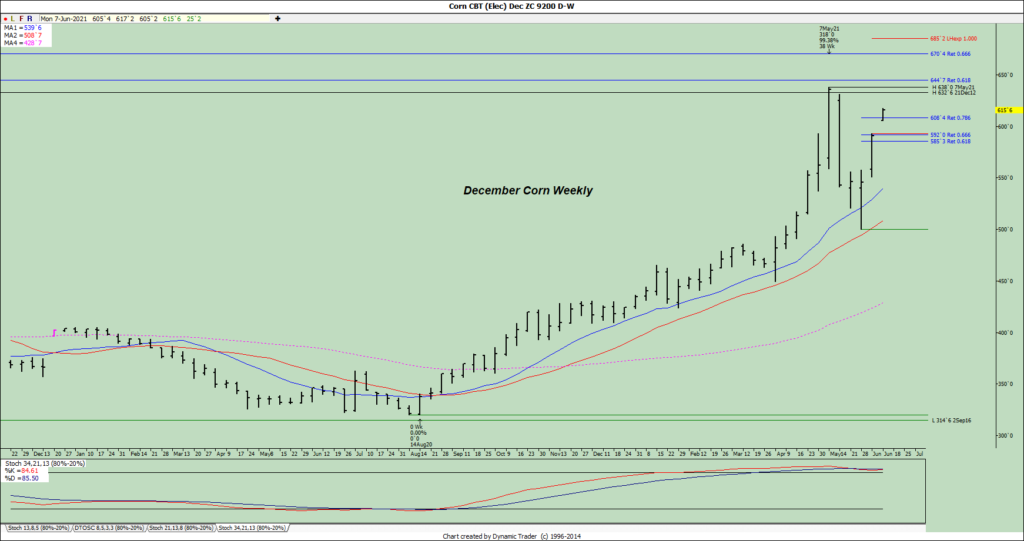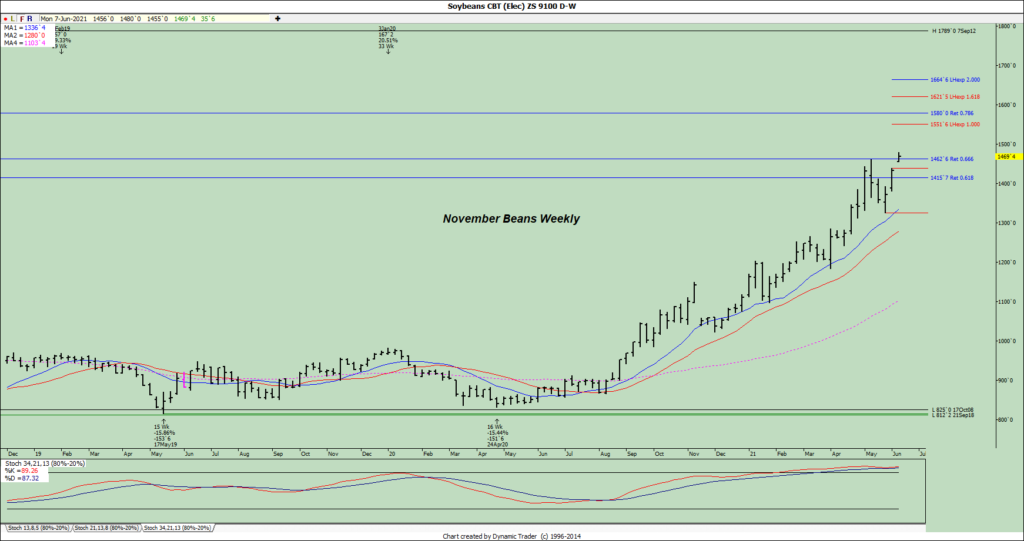No summer weather market would be worth it’s salt if it did not contain at least one weekly gap higher. While not every contract gapped above last week’s highs when we opened last night, but the two that matter in weather markets, i.e., new corn and beans, did so decisively. Assuming (which we know can be dangerous) these holes are left unfilled through at least the close on Wednesday; they would provide us with potential upside targets of 6.85 in December corn and 15.52 in November beans. Needless to say, the sparse amount of moisture and rising temperatures witnessed throughout much of the Midwest over the weekend, along with the forecast for more of the same, is the primary catalyst this morning.
With the weather on the forefront, I am not sure if anyone will pay much mind to the June production and supply/demand estimate, but nevertheless, the USDA will release these numbers on Thursday. If there is a point of interest, it will likely be in any changes made with South American production. Here are a few trade estimates; Total corn production of 15.009 billion from a yield of 179.4 bpa. 2020/21 ending stocks are expected to slip to 1.203 billion, with 2021/22 then coming in at 1.417 billion. Bean production is expected to total 4.411 billion from a yield of 50.8 bpa. 2020/21 ending stocks of 122 million and 2021/22 increasing to 143. This year’s total wheat production is estimated to reach 1.891 billion bushels, with 2020/21 ending stocks coming through at 868 million and 2021/22 at 781 million. Last but not least, Brazilian corn is estimated to total 97 MMT with beans at 136.1, and in Argentina, corn production is projected to total 47 MMT and beans 46.5.
Brazilian bean shipments to China picked up some momentum as weather delays subsided. During the month, China unloaded 9.61 MMT of Brazilian beans, which was up from 7.45 MMT the previous month. This was also a smidge better than the same month in 2020 when they brought in 9.38 MMT.
Large Specs returned to the buyer table in most grain and soy markets last week. They were net sellers of almost 2,500 contracts of wheat, but it would appear much of that action was unwinding long KC/short Chicago spreads. They were back for almost 18,000 contracts of corn, nearly 4,000 beans, and 3,500 oil. Meal quite literally got the short end of the stick, or spread in this case, as they sold almost 2,500 contracts.
Of course, as I commented initially this morning, the weather outlook trumps all else for the moment, and the morning updates do not appear promising. There are a few rain chances early this week, but to quote from the report I read this morning from World Weather, Inc., “By June 21st, much of the Midwest will be significantly drier than today, and stress to crops should have expanded outward from the eastern Dakotas and western Minnesota into portions of Nebraska, Iowa, Wisconsin, and Michigan.” That would sound like a recipe for out-of-control markets.
There is one caveat that I would throw out, though. We have been talking about weather and food inflation for some time now, and not only can people become a bit numb to such news, but it has also reached the headline stage, and often that only happens when you are into the tail end of a move. Last week, the UN Food and Agriculture Organization released the May food price index number, which reflected a 40% increase, and marked the largest year-on-year rise since 2011. Not only is this a well-known fact, but we are also probably approaching the point when governments begin to do silly things to try and keep this in check.

